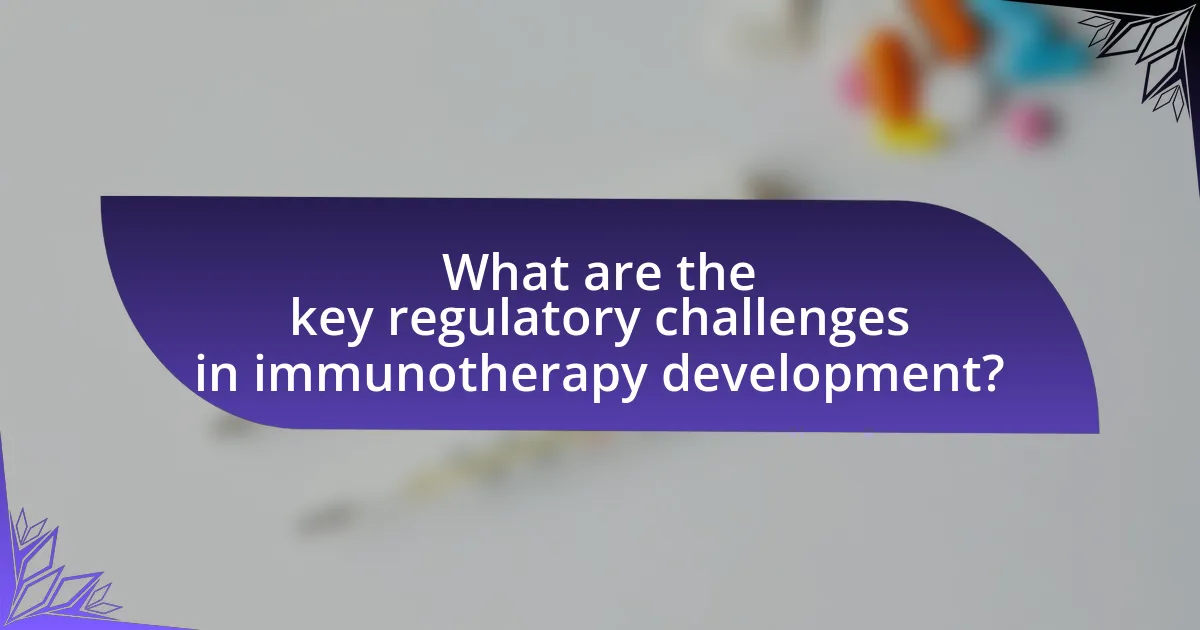The article focuses on the regulatory challenges faced in the development of immunotherapy, a treatment that utilizes the body’s immune system to combat diseases, particularly cancer. Key challenges include the need for robust clinical trial designs, long-term safety assessments, and the establishment of appropriate biomarkers for patient selection. It outlines how regulatory agencies define immunotherapy, the classifications within this field, and the implications of these classifications on regulatory pathways. Additionally, the article emphasizes the importance of regulatory compliance, the role of clinical trials in approval processes, and strategies for developers to navigate the regulatory landscape effectively. Emerging trends, future challenges, and best practices for ensuring regulatory success are also discussed, highlighting the evolving nature of immunotherapy regulation.

What are the key regulatory challenges in immunotherapy development?
The key regulatory challenges in immunotherapy development include the need for robust clinical trial designs, the assessment of long-term safety and efficacy, and the establishment of appropriate biomarkers for patient selection. Regulatory agencies require comprehensive data to demonstrate that immunotherapies are both effective and safe, which can be complicated by the unique mechanisms of action and variability in patient responses. Additionally, the evolving nature of immunotherapy necessitates ongoing dialogue with regulatory bodies to address novel therapeutic approaches and their implications for existing regulatory frameworks.
How do regulatory agencies define immunotherapy?
Regulatory agencies define immunotherapy as a treatment that harnesses the body’s immune system to fight diseases, particularly cancer. This definition encompasses various modalities, including monoclonal antibodies, vaccines, and cell therapies, which are designed to enhance or restore immune function. For instance, the U.S. Food and Drug Administration (FDA) recognizes immunotherapy as a significant advancement in cancer treatment, emphasizing its role in targeting specific cancer cells while minimizing damage to healthy tissue. This definition is supported by the increasing number of approved immunotherapeutic agents, which have demonstrated efficacy in clinical trials, thereby validating the regulatory perspective on immunotherapy as a transformative approach in modern medicine.
What classifications exist within immunotherapy?
Immunotherapy can be classified into several main categories: monoclonal antibodies, immune checkpoint inhibitors, cancer vaccines, adoptive cell transfer, and cytokines. Monoclonal antibodies target specific antigens on cancer cells, while immune checkpoint inhibitors block proteins that prevent immune cells from attacking tumors. Cancer vaccines stimulate the immune system to recognize and attack cancer cells. Adoptive cell transfer involves modifying a patient’s immune cells to enhance their ability to fight cancer. Cytokines are signaling proteins that can boost the immune response against cancer. These classifications are essential for understanding the diverse approaches in immunotherapy and their regulatory implications.
How do these classifications impact regulatory pathways?
Classifications significantly impact regulatory pathways by determining the level of scrutiny and the specific requirements for approval. For instance, therapies classified as breakthrough therapies may receive expedited review processes, while those categorized as standard treatments face more extensive evaluation. The U.S. Food and Drug Administration (FDA) provides distinct regulatory frameworks based on these classifications, which can influence timelines and resource allocation during the development process. This differentiation is crucial as it can accelerate patient access to innovative therapies, as seen with the FDA’s designation of over 100 therapies as breakthrough since its inception in 2012, highlighting the tangible effects of classification on regulatory efficiency.
Why is regulatory compliance critical in immunotherapy?
Regulatory compliance is critical in immunotherapy because it ensures the safety, efficacy, and quality of treatments before they reach patients. Compliance with regulations set by authorities such as the FDA or EMA involves rigorous testing and validation processes, which help to identify potential risks and side effects associated with new therapies. For instance, the FDA’s approval process requires extensive clinical trials that demonstrate a drug’s effectiveness and safety, which is essential for gaining public trust and ensuring patient protection. Non-compliance can lead to severe consequences, including the withdrawal of therapies from the market, legal repercussions, and harm to patients.
What are the consequences of non-compliance?
Non-compliance in immunotherapy development can lead to severe consequences, including legal penalties, financial losses, and delays in product approval. Regulatory bodies, such as the FDA, impose fines and sanctions on companies that fail to adhere to established guidelines, which can amount to millions of dollars. Additionally, non-compliance can result in the rejection of clinical trial applications, prolonging the time it takes to bring therapies to market. For instance, a study by the National Institutes of Health highlighted that companies facing compliance issues often experience an average delay of 2-3 years in obtaining necessary approvals, significantly impacting their competitive edge and financial viability.
How does compliance affect patient safety and efficacy?
Compliance directly enhances patient safety and efficacy by ensuring that healthcare practices adhere to established regulations and standards. When healthcare providers and pharmaceutical companies follow compliance protocols, they minimize the risk of errors, adverse events, and ineffective treatments. For instance, adherence to Good Clinical Practice (GCP) guidelines in clinical trials has been shown to improve the reliability of data, which is crucial for assessing the safety and efficacy of immunotherapies. A study published in the Journal of Clinical Oncology found that compliance with regulatory standards significantly reduced the incidence of serious adverse events in clinical trials, thereby reinforcing the importance of compliance in safeguarding patient outcomes.
What role do clinical trials play in regulatory approval?
Clinical trials are essential for regulatory approval as they provide the necessary evidence of a drug’s safety and efficacy. Regulatory agencies, such as the FDA and EMA, require data from clinical trials to assess whether a new treatment meets the established standards for market authorization. For instance, the FDA mandates that clinical trials follow a rigorous protocol, including phases I through III, to evaluate the drug’s effects on human subjects. This process ensures that any potential risks are identified and that the benefits outweigh those risks, which is critical for patient safety and informed decision-making.
What are the phases of clinical trials for immunotherapy?
The phases of clinical trials for immunotherapy are typically categorized into four main stages: Phase 1, Phase 2, Phase 3, and Phase 4. Phase 1 trials primarily focus on assessing the safety and tolerability of the immunotherapy in a small group of participants, often involving dose escalation to determine the maximum tolerated dose. Phase 2 trials evaluate the efficacy of the treatment in a larger group while continuing to monitor safety. Phase 3 trials involve even larger populations to confirm efficacy, monitor side effects, and compare the new treatment to standard therapies. Finally, Phase 4 trials, also known as post-marketing studies, occur after the treatment has been approved and are designed to gather additional information on the drug’s risks, benefits, and optimal use in the general population.
How do trial designs influence regulatory outcomes?
Trial designs significantly influence regulatory outcomes by determining the robustness of evidence submitted for drug approval. Well-structured trial designs, such as randomized controlled trials, provide clear comparisons between treatment and control groups, which regulatory agencies like the FDA and EMA rely on to assess efficacy and safety. For instance, the FDA’s approval of pembrolizumab for melanoma was based on a trial design that included a clearly defined primary endpoint and a well-characterized patient population, demonstrating the treatment’s effectiveness. Conversely, poorly designed trials can lead to inconclusive results, delaying or preventing regulatory approval, as seen in cases where endpoints were not adequately defined or patient selection was biased. Thus, the quality and clarity of trial designs directly impact the likelihood of successful regulatory outcomes.

How can developers navigate the regulatory landscape effectively?
Developers can navigate the regulatory landscape effectively by staying informed about current regulations and engaging with regulatory bodies early in the development process. This proactive approach allows developers to understand the specific requirements for immunotherapy products, such as clinical trial protocols and safety assessments. For instance, the U.S. Food and Drug Administration (FDA) provides guidance documents that outline the regulatory expectations for new therapies, which can help developers align their projects with these standards. Additionally, participating in industry forums and workshops can facilitate knowledge sharing and provide insights into best practices for compliance.
What strategies can be employed to ensure regulatory success?
To ensure regulatory success in immunotherapy development, organizations should implement comprehensive preclinical and clinical trial designs that align with regulatory guidelines. This involves early engagement with regulatory agencies, such as the FDA or EMA, to clarify requirements and expectations, which can significantly reduce the risk of non-compliance. For instance, the FDA’s guidance on the development of cancer immunotherapies emphasizes the importance of understanding the mechanism of action and the potential for biomarkers to predict patient response. Additionally, maintaining robust data management practices and ensuring transparency in reporting trial results can facilitate smoother regulatory reviews. Historical examples, such as the accelerated approval of pembrolizumab, demonstrate that proactive communication and adherence to regulatory frameworks can lead to successful outcomes in bringing immunotherapies to market.
How can early engagement with regulatory agencies benefit developers?
Early engagement with regulatory agencies benefits developers by facilitating a clearer understanding of regulatory requirements and expectations. This proactive approach allows developers to align their research and development processes with regulatory standards, reducing the risk of costly delays and rework. For instance, early discussions can lead to valuable feedback on clinical trial designs, which can enhance the likelihood of successful approvals. According to a study published in the Journal of Clinical Oncology, companies that engaged with the FDA early in the drug development process experienced a 30% faster time to market compared to those that did not. This demonstrates that early regulatory engagement not only streamlines the development process but also increases the chances of successful product launch.
What resources are available for understanding regulatory requirements?
Regulatory agencies provide several resources for understanding regulatory requirements. The U.S. Food and Drug Administration (FDA) offers guidance documents, which outline the regulatory framework for drug development, including immunotherapy. Additionally, the European Medicines Agency (EMA) publishes guidelines that detail the regulatory processes in Europe. Both agencies maintain websites with comprehensive information, including FAQs, webinars, and training materials that help stakeholders navigate the regulatory landscape. Furthermore, industry associations, such as the Biotechnology Innovation Organization (BIO), provide resources, including reports and best practice guidelines, to assist in understanding and complying with regulatory requirements.
What common pitfalls should developers avoid?
Developers should avoid common pitfalls such as inadequate understanding of regulatory requirements, insufficient documentation, and lack of stakeholder engagement. A thorough understanding of regulatory frameworks is essential, as misinterpretations can lead to non-compliance and project delays. Insufficient documentation can result in difficulties during audits and hinder the approval process, as regulatory bodies require comprehensive records to assess safety and efficacy. Additionally, failing to engage stakeholders, including regulatory agencies and patient advocacy groups, can lead to misalignment of expectations and missed opportunities for valuable feedback. These pitfalls can significantly impact the success of immunotherapy development projects.
How can inadequate data impact regulatory submissions?
Inadequate data can lead to significant delays or rejections in regulatory submissions. Regulatory agencies, such as the FDA and EMA, require comprehensive and robust data to assess the safety and efficacy of immunotherapy products. Insufficient data may result in a lack of confidence in the product’s performance, prompting regulators to request additional studies or information, which can extend the approval timeline. For instance, a study by the FDA indicated that 30% of drug applications were delayed due to incomplete data submissions. This highlights the critical importance of thorough data collection and analysis in ensuring successful regulatory outcomes.
What are the risks of underestimating timelines and costs?
Underestimating timelines and costs in immunotherapy development poses significant risks, including project delays, budget overruns, and compromised quality of research. These risks can lead to failure in meeting regulatory requirements, as evidenced by the fact that 70% of drug development projects exceed their initial timelines and budgets, according to a study by the Tufts Center for the Study of Drug Development. Additionally, inadequate financial planning may result in insufficient resources for critical phases, such as clinical trials, which are essential for regulatory approval. This can ultimately jeopardize the entire project, leading to wasted investments and lost opportunities in the competitive field of immunotherapy.

What are the emerging trends in immunotherapy regulation?
Emerging trends in immunotherapy regulation include increased emphasis on adaptive trial designs, real-world evidence integration, and expedited approval pathways. Regulatory agencies, such as the FDA and EMA, are adopting more flexible frameworks to accommodate the rapid advancements in immunotherapy, allowing for iterative development and faster patient access. For instance, the FDA’s Breakthrough Therapy designation facilitates quicker review processes for promising therapies, reflecting a shift towards prioritizing innovative treatments. Additionally, the incorporation of real-world evidence is becoming crucial, as it helps regulators assess the effectiveness and safety of immunotherapies in broader patient populations outside of clinical trials. These trends indicate a proactive approach to balancing patient safety with the need for timely access to novel therapies.
How is the regulatory landscape evolving with new technologies?
The regulatory landscape is evolving to accommodate new technologies by implementing adaptive frameworks that allow for faster approval processes and increased collaboration between regulatory bodies and innovators. For instance, the U.S. Food and Drug Administration (FDA) has introduced initiatives like the Breakthrough Therapy Designation, which expedites the development and review of drugs that treat serious conditions and fill an unmet medical need. This shift is evidenced by the FDA’s approval of 53 breakthrough therapies in 2020 alone, reflecting a trend towards more flexible regulatory approaches that can keep pace with rapid advancements in fields such as immunotherapy.
What impact do personalized medicine and biomarkers have on regulation?
Personalized medicine and biomarkers significantly influence regulatory frameworks by necessitating tailored approval processes that account for individual patient variability. Regulatory agencies, such as the FDA, have adapted guidelines to incorporate biomarker-driven approaches, which facilitate the development of targeted therapies. For instance, the FDA’s 2018 guidance on the use of biomarkers in drug development emphasizes the importance of these tools in identifying patient populations likely to benefit from specific treatments, thereby streamlining the approval process. This shift towards personalized approaches not only enhances the efficacy of therapies but also raises challenges in ensuring consistent regulatory standards across diverse biomarker applications.
How are adaptive trial designs changing regulatory approaches?
Adaptive trial designs are transforming regulatory approaches by allowing for more flexible and efficient evaluation of new therapies. These designs enable modifications to trial parameters based on interim results, which can lead to faster decision-making and resource allocation. For instance, the FDA has embraced adaptive designs in its guidance documents, recognizing their potential to expedite the development of innovative treatments, particularly in areas like immunotherapy. This shift is evidenced by the increasing number of approved drugs that utilized adaptive trial methodologies, demonstrating their effectiveness in meeting regulatory standards while addressing urgent medical needs.
What future challenges might arise in immunotherapy regulation?
Future challenges in immunotherapy regulation may include the need for adaptive regulatory frameworks that can keep pace with rapid advancements in technology and treatment methodologies. As immunotherapies evolve, regulators will face difficulties in establishing consistent guidelines for evaluating safety and efficacy, particularly for personalized therapies that target specific patient populations. Additionally, the complexity of combination therapies may complicate approval processes, as existing frameworks may not adequately address the interactions between multiple agents. Furthermore, ensuring equitable access to these therapies while managing costs and reimbursement models will pose significant regulatory hurdles. These challenges are underscored by the increasing number of clinical trials and the diverse mechanisms of action associated with new immunotherapeutic agents, necessitating ongoing dialogue between stakeholders to refine regulatory approaches.
How could global regulatory harmonization affect development?
Global regulatory harmonization could significantly streamline the development of immunotherapies by creating uniform standards across countries. This alignment reduces the complexity and costs associated with navigating multiple regulatory frameworks, allowing for faster approval processes. For instance, the International Council for Harmonisation of Technical Requirements for Pharmaceuticals for Human Use (ICH) has established guidelines that, when adopted globally, can expedite clinical trials and market access. Consequently, harmonization can enhance collaboration among researchers and manufacturers, ultimately leading to more efficient innovation and improved patient access to new therapies.
What role will patient advocacy play in shaping regulations?
Patient advocacy will play a crucial role in shaping regulations by ensuring that the voices and needs of patients are integrated into the regulatory process. Advocacy groups actively engage with regulatory bodies, providing insights on patient experiences and treatment priorities, which can influence policy decisions. For instance, the FDA’s Patient-Focused Drug Development initiative incorporates patient perspectives to inform drug approval processes, demonstrating the impact of advocacy on regulatory frameworks. This collaboration can lead to more patient-centered regulations that prioritize safety, efficacy, and accessibility in immunotherapy development.
What best practices should developers follow for regulatory success?
Developers should follow best practices such as early engagement with regulatory authorities, thorough documentation, and adherence to established guidelines for regulatory success in immunotherapy development. Early engagement allows developers to clarify expectations and requirements, which can streamline the approval process. Thorough documentation ensures that all data and processes are transparent and traceable, facilitating regulatory review. Adhering to established guidelines, such as those from the FDA or EMA, helps ensure compliance with safety and efficacy standards, which is critical for successful regulatory outcomes. These practices are supported by the fact that companies that engage early with regulators often experience shorter review times and higher approval rates, as evidenced by various case studies in the pharmaceutical industry.
How can continuous learning and adaptation improve compliance?
Continuous learning and adaptation can significantly improve compliance by enabling organizations to stay updated with evolving regulations and best practices. This proactive approach allows companies in immunotherapy development to identify compliance gaps and implement necessary changes swiftly. For instance, organizations that regularly train their staff on new regulatory requirements and industry standards are better equipped to meet compliance obligations, as evidenced by a study from the Regulatory Affairs Professionals Society, which found that companies with ongoing training programs had a 30% lower incidence of compliance violations. By fostering a culture of continuous improvement, organizations can enhance their ability to navigate complex regulatory landscapes effectively.
What collaborative approaches can enhance regulatory navigation?
Collaborative approaches that can enhance regulatory navigation include public-private partnerships, stakeholder engagement, and cross-sector collaborations. Public-private partnerships facilitate the sharing of resources and expertise, which can streamline the regulatory process by aligning industry goals with regulatory requirements. Stakeholder engagement, involving patients, healthcare providers, and regulatory bodies, ensures that diverse perspectives are considered, leading to more informed decision-making. Cross-sector collaborations, such as those between academia and industry, can foster innovation and provide comprehensive data that supports regulatory submissions. These approaches have been shown to improve the efficiency of regulatory pathways, as evidenced by initiatives like the FDA’s Breakthrough Therapy Designation, which accelerates the development of therapies that address unmet medical needs through collaborative efforts.



